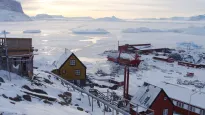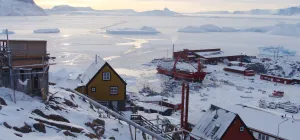Alternate hypothesis emerges to explain circular structure on King Baudouin Ice Shelf

Since a team of scientists from the Alfred Wegener Institute (AWI) spotted a large circular ice structure during a geological survey flight above the King Baudouin Ice Shelf in Antarctica, glaciologists have been discussing the possibility that it could in fact be a giant ice doline, rather than an impact site for a meteorite.
Social media as a discussion forum
Jan Lenaerts, a glaciologist at Utrecht University who was also at the Princess Elisabeth Station this season studying the King Baudouin Ice Shelf, informed Graeme Eagles, leader of the AWI geological survey, that he and several glaciologists in the international scientific community (including Frank Pattyn at the Université Libre de Bruxelles, Doug MacAyeal from the University of Chicago, and Allen Pope from the NSIDC in Colorado) were discussing the circular structure in the King Baudouin Ice Shelf on social media.
The glaciologists were leaning towards an alternate explanation for the feature: an ice doline.
An ice doline is a kind of crater that is not as widely known or thought about as meteorite craters. They form when cavities in glaciers or ice sheets cave in, in much the same way as sinkholes can form over caves in limestone areas. In glaciers, the cavities form much more rapidly than limestone caves, by the drainage of meltwater from so-called englacial lakes or water pockets. Ice dolines have been known since the 1930s from observations of ice craters in Greenland and the Antarctic Peninsula, where the ice melts in summertime in larger quantities.
New hypothesis, new questions
Just like with the impact crater hypothesis, new questions are starting to come to mind as a result of the ice doline hypothesis. Ice dolines are a well known phenomenon on ice shelves in West Antarctica, which has been losing ice at an increasing pace. If ice dolines are more common than previously thought in East Antarctica - a region where ice mass balance has been relatively stable - it may force researchers to reconsider how stable East Antarctica is in terms of ice mass loss.
For the AWI survey team, the last few days have shown that modern scientific discussion is not confined to the ivory towers of learned meetings, technical papers, and lecture halls, but that public fora and social media play a tremendous role.
What's next?
The hard drives containing the terabytes of data that were collected by the Polar 6 team will travel back to Bremerhaven and be analyzed over the next few months. If the results enable either or both hypotheses to be ruled out, an article about the process will be prepared for peer review, publication, and further discussion amongst the scientific community. Usually, this process generates follow-up questions, which might require new field resarch.
For his part, Jan Lenaerts has already expressed interest in visiting the circular structure during the 2015-16 research season, as he continues research for the BENEMELT project he's currently working on, thanks to a research grant from the InBev-Baillet Latour Antarctica Fellowship. The BENEMELT project aims to investigate how much snow melts on ice shelves in East Antarctica, by how much melt will increase in the future, and how it could impact ice shelf stability and resulting sea level rise.
The Princess Elisabeth station team looks forward to supporting glaciological resarch next season!
A follow-up interview with AWI survey team leader and geophysicist Graeme Eagles is available on www.sciencepoles.org






















